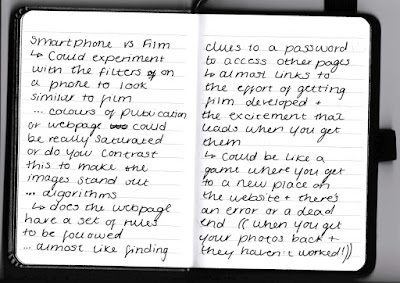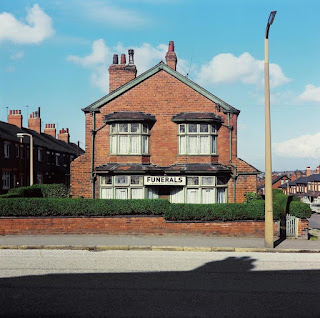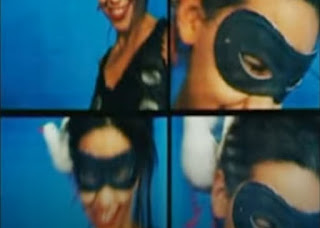Wednesday, 30 September 2020
Task 1: Lomography Poster
Tuesday, 29 September 2020
Initial Ideas
Peter Mitchell / Typology
Creating a map of Leeds and highlighting the places he photographed. Could photograph them on film and compare and contrast. Possibly too 'guide book' like. Could make a book inspired by his documentary photography but do it in another city - Hull?
Focus on repetition of the same subject and the way that he formats his photos (typology). Very contrasting composition and subject matter. The former being very formal and rigid, the latter the crumbling and decaying North of England. Working Title idea: 'Rave On' based on Mitchell's photo of Buddy Holly graffiti that sparked debate about the origins of the term and whether it was photoshopped or not.
Nostalgia plays a big part in this. Mitchell's photos are memory triggering, safe feeling, like you've been there before. Perhaps focus on memory - produce a photo album? Using personal family photos or new ones. Family photos would be sincere, but could play on that humorous juxtaposition by using informal photos in a formal setting. Working Title idea: 'The Family Photo Album'
Perhaps have a series of photos that become more and more over exposed so as you look through them, they mirror time moving on and memories fading.
Lomography
Could produce a document going through the 10 golden rules of Lomography. This would include image and text and would make an interesting photo book. Could perhaps design a symbol for each rule?
The physicality's of a publication based on Lomography would have to be playful, plastic and colourful - like the cheaply produced cameras that are made for having fun. This could include a plastic spiral binding and colourful pages.
Could produce a photo book of personal pictures documenting student life in response to how Lomography began (in a student flat). Or could produce a book of student film submissions.
Key Words
Personal
Physical
Nostalgic
Tangible
Intimate
Controversial
Playful
Experimental
Publication or Screen Based?
At the moment I'm leaning towards producing a publication because film is so physical and a tactile experience, so it makes sense to produce a physical object. When I think about film I think about holding a weighty photo album and carefully turning the pages or flicking through a stack of 6 x 4 photos I just picked up from the shop, ready to slide them into place behind little plastic covers. All in all it's a physical experience for me, and that's what makes it so different to digital photography online.
However, to make a case for digital, every time I take photos and pick them up from being developed, the first thing I do is scan them in. Despite almost dying multiple times, film has managed to co-exist alongside the developing digital world. It could be very interesting to merge them.
This could actually work really well for Lomography. The Lomographic society began in the early 90s and was primarily for students and to encourage them to have fun with photography. Now, however, because Lomography doesn't have a big online presence the teenagers of today don't know anything about it. It could be really interesting to create a website for the Lomographic Society that is primarily focused on engaging with students - with a section outlining the rules and a gallery etc.
It's actually mad that Lomography don't have a bigger online presence. Rather than producing an app, they decided to double down on the analogue side of things. However, with film photography becoming so trendy it's surprising that they haven't really tried to engage with young people who are getting into it. The most I've seen is a TikTok of someone who previously only used disposable cameras, explain how they switched to the Lomo Simple Use Camera (which they called a 're-usable disposable camera') to cut down on plastic waste. - This just goes to show that young people are interested, but they don't understand what Lomography is because they aren't making themselves known.
Tuesday, 22 September 2020
Research Summary
I chose film photography for my interest because I have been taking photos on film now since January last year and I find documenting my friends and surroundings fun. I like the idea of building a physical collection of memories rather than just taking digital photos and think that this links to my preference for print rather than digital as whole. As well as this the process is a lot more interesting and complex in comparison to taking digital photos. I really enjoy taking myself to pick up some prints and taking the time to look though them. Furthermore, over lockdown I began to look through my mum's collection of film photos from her early twenties and found it fascinating to see. I've always relished the nostalgia of looking through old family photographs (my grandpa has a large collection of albums that have photos of their travels, beer mats, tickets, receipts etc.) and while hoping to inherit them, I have started a collection of my own.
By researching some of the photographers that I like I have been able to analyse why I like film photography. For example, Ian Howorth's photos have lots of nostalgic tendencies and have a sense of tranquillity and quiet contemplation. The stand-of-ish nostalgia that is exhibited in Howarth's photos are inexplicably British to me, much like Peter Mitchell's photography. I am interested in Mitchell's work because looking at his photographs of Leeds in the 1970s and 80s is almost like looking at a family members, as the places are so familiar and the photographs so comforting.
Furthermore, looking back into the history of film photography really opened my eyes and made me thankful that I am even able to shoot on film. I learnt about Florian Kaps - someone that was simply a big enough of fan of Polariod that when it abandoned instant film, managed to convince the comapny's production manager to help him continue making film. Secondly when Kodak stopped producing Ektachrome film, they were convinced to revive it five years later by fans. I love how this goes to show that whatever new technology is introduced, analogue will always be around.
Finally, Lomography was a very interesting part of film photography history to look at due to it's connections to the Soviet Union, however, the most interesting thing about it's history was the way that it began. Being able to create an entire movement from a communal passion for one camera, the Lomo Kompakt, is so admirable. Especially as Fiegl and Stranziger were doing exactly what I, and so many other young people, am now - taking stupid photos of their friends to keep as memories.
Monday, 21 September 2020
Peter Mitchell: Early Sunday Morning, Signs & Reasons
https://americansuburbx.com/2020/09/peter-mitchell-early-sunday-morning-signs-reasons.html
It is somehow impossible not to mention the overriding influence of Walker Evans when we speak about the presence of vernacular signage in photographic practice. It was a focus within Evan’s work and though he did not invent the eye for making images of business advertisements, signage or advertising per se, he did set the precedent for their inclusion in a certain canon of street photography or oblique documentary practice-the semantics of which he would certainly disavow. I have assumed this focus on the found vernacular to be American in nature. However, the details of national ownership is missing apart from the rise of American modernism or the focus on its anti-thesis, namely quaint small town America advertising often hand painted and rough.
There is no specific need to consider the historical focus of an artist working on the street thinking through signs and signage in their environment other than what specifically endears us to their work is not necessarily the gift of their prowess, but rather that we remember of these images for how what is in their frame triggers nostalgia. “Remember When?”. You can almost audibly queue music with a memory triggered by specific sign at the local ma and pa or off-license. Candy endorsements in particular create a specific liminal moment when you see an advertisement for them in the window of a shop front. Atget and Evans exemplified a particular moment in each of their respective countries, both angling on a particular side of the modernist moment. With Atget’s work, you see a slide towards the end of an opulent age before WWI and with Evans, you see an America on the cusp of change before WWII.
Saturday, 19 September 2020
Peter Mitchell
I first came across Peter Mitchell's photography when I found his Instagram - @StangelyFamiliar.co.uk. I wasn't aware of the photographer's name or the history behind any of the images on the Instagram page, but was sucked in by the evident nostalgia. A few months later I started to see posters around Leeds with the same images as the Instagram page as well as the handle, however, they had Peter Mitchell's name on.
I began to do my research and learnt that Peter Mitchell is a documentary photographer and is most know for his work documenting shops, cafe's, and factories in Leeds in the 1970's and 80's. He has published 7 photo books throughout his career and each one shows how he treats his surroundings with immense care within his work.
The book that I am the most interested in and the one being advertised currently is Mitchell's latest publication Early Sunday Morning. The book is made up of over 90 largely unpublished images, each one selected from a cache of five hundred negatives which have sat unseen for over 30 years. The book reveals the layers of the city’s history, exposed by the changes to the urban landscape that epitomised the 1970s and 80s. Hundred-year-old terraces and cobbled streets sit flanked by concrete flats, with newly cleared ground to either side are presented with Mitchell’s typical graphic framing.
Out of all of Mitchell's work depicting Leeds, the photos from Early Sunday Morning are the most intimate and personal. It is neither the sombre look at destruction seen in Memento Mori, nor the detached view of ‘the man from mars’ of A New Refutation of the Viking 4 Space Mission, but a more intimate document of Mitchell’s own Leeds. I find myself drawn to it the most because of the collaboration with Leeds gallery Colours May Vary. The gallery published the posters with Mitchell's photography and stated the locations that they were taken. For example one poster, pictured below, has a picture of The Primrose Pub on Meanwood Road. Because I live on Meanwood Road, right after seeing this picture I went home to photograph the pub and realised it looked almost exactly the same as when Mitchell photographed it.
Mitchell has numerous books that show the documentation of Leeds - such as Strangely Familiar which shows the photographs Mitchell took of Leeds people and their places of work whilst he travelled the city as a truck driver. He photographed factories and shops formally with the use of a step ladder. He also documented the downfall of the Quarry Hill Flats in Leeds in the 1970's, which can be seen in his book Momento Mori. He said about his work depicting the housing estate: “I photograph dying buildings and Quarry Hill was terminal by the time I got to it. Times change and I know there was no point in keeping Quarry Hill Flats. But what it stood for might have been worth remembering.”
Friday, 18 September 2020
BBC Documentary - The LOMO Camera: Shoot From The Hip
https://www.youtube.com/watch?v=8TiAsvYgyqU&feature=emb_logo
Lomography is an international communication project. They look at very mundane things that do not look exciting themselves but say things about the society that we live in and the way we live our lives. Lomography is about lifestyle and philosophy. It's passionate, democratic and playful.
"I love details, I love other people, I have a super positive feeling about the little things."
Simone White: "It really opens your eyes, always having a camera on you. I stopped thinking, and just started shooting everything. It's a way of thinking and engaging. Lomography is about the little details in life."
The story of the Lomography Society:
Wolfgang Stranziger and Matthias Fiegl met at boy scouts and became good friends. They moved to Vienna for their studies and began living together an a very student prominent area. It was a typical student apartment with a lot of people coming and going. The apartment was always busy and they discussed philosophy, architecture, and art every night. In this environment, Matthias began taking photos with the Lomo Kompakt camera. Due to the Russian lens, the photos came out more colourful and the edges were slightly black, making the focus the centre of the picture.
Very quickly they began to popularise the camera. After a couple of months, around fifty people in Vienna were using the Lomo Kompakt. Stranziger and Fiegl liked that all of these people were looking at the world through the same lens, and wanted to organise an exhibition - but first they had to form a society (this was a very Viennese thing to do, and they also just found it funny). Following the society they introduced the 10 Golden Roles of Lomography.
They loved holding exhibitions and throwing parties, but could not get sponsors to pay for it. So they paid for it by selling cameras. They told people that bought cameras that they were not just buying cameras, but a membership to the Lomography Society. The problem, however, was smuggling the cameras out of Russia. They had to travel 2 hours out Moscow to find a box of 700 Lomo cameras.
Stranziger and Fiegl decided to branch out to New York and Moscow. In America, it was still illegal to promote a Russian product.
The story of LOMO the company:
For almost a century the huge Lomo factory in St. Petersburg has been at the forefront of soviet optics. Lomo is a multi-faceted company, active and science and technology. Their products include cameras, telescopes, night surveillance equipment, equipment for the navy, and rocket components. The company began in 1914, at the beginning of the First World War. The company was set up to make optical instruments for the Russian Army. Employees were treated harshly and there were riots, then in 1917 the Socialist Revolution took place. Workers took over the factory, but then the Civil War began and the workers left to defend the Revolution. 200 stayed, and conditions were harsh. It was then when they produced the first Soviet film camera.
The Lomography Society wrote to the people at LOMO, who were completely unaware of the reason for the rising popularity of their camera, and invited them to an exhibition in Moscow. However, the invitation was sent on April 1st - and so they thought it was a joke.
A lot of the new LOMO cameras take multiple pictures at once. For example, the Action Sampler Camera has 4 lenses and takes images that are intended to look new and unique, and are focused on movement.
In Hong Kong, two Lomographers started a project called A Day In The Life - where they use Lomography to document their days.
Module Evaluation
This module has been really positive for me. I'm so glad that I chose the issue that I did, because I felt passionate and motivated the ...
-
I resized my InDesign pages to he correct size and did a small print run of a couple of pages to identify any issues. The main one being ver...
-
- Attempting to continue with current theme by developing a anthropomorphised fruit character - This was interesting in theory...



























































